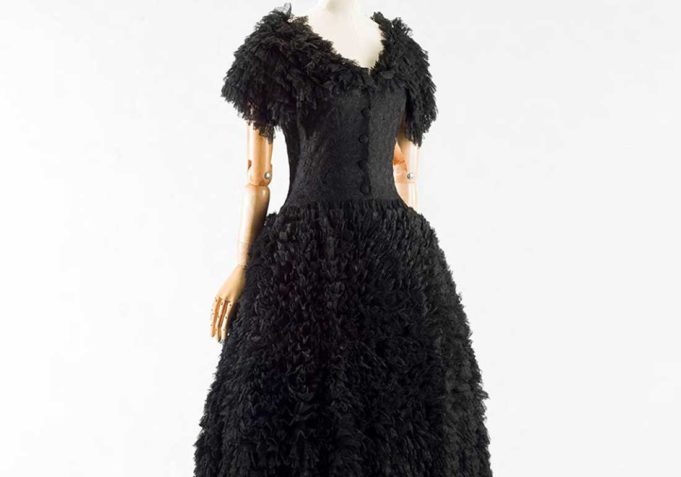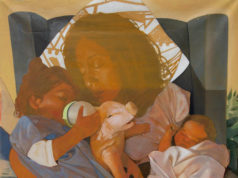Balenciaga in Black isn’t lacking in sex appeal.
Dozens of impossibly tight-waisted dresses and evening gowns hover behind thick glass walls in a state of grace and eerie calm at the Kimbell Art Museum. For the One Percenters of the mid-20th century, courtship and social mores took on a level of extravagance (and cost) that few of us can relate to. Even today, a custom dress from the namesake fashion chain of deceased designer Cristóbal Balenciaga can easily run into the tens of thousands of dollars.
Kimbell staffers went to great lengths to add a strong educational component to this homage to Balenciaga, which occupies the south gallery of the Piano Pavilion. Near the gallery entrance, large text on a wall encourages visitors to download a similarly titled app that provides a guided tour and supplemental interview material by Véronique Belloir, who co-curated the exhibit and works at the Paris-based fashion museum Palais Galliera.
The space is basically partitioned into four quadrants that nudge viewers onward in a clockwise manner. The first room is dedicated to the craft of garment design and creation. White lines drawn across black toiles (thin fabric) capture the moment hand-scribed drawing met linen. Small pieces of paper bearing Balenciaga’s notes bring viewers close, at least in spirit, to the fashion icon.
Indeed, his presence weighs heavily on the show through his numerous sketches, drawings, notes, and hand-cut textiles. Three nearby adjacent mannequins show the creative process as the toiles were cut, draped, and sewn into the final product. Just feet from the relics lay dozens of Balenciaga’s otherwordly creations. High fashion is typically associated with movement — the bustle of a gala, the flashing strobes that illuminate runway models. Seeing these stark pieces held immutable lent an eerie, ghostly feel to the show.
Form trumps function in two bizarre creations. In Dress Winter 1967, the designer used a rigid material called gazar to craft the shoulder area into protruding spires that jut several inches outward. The dress is otherwise traditional with jeweled shoulder straps that can be viewed only from behind the garment. Evening Dress and Cape Ensemble would have turned heads for women brazen enough to cocoon themselves within its consuming folds. The outfit obscures the upper torso of the wearer with a thick shroud that leaves only the head visible.
“That really makes a statement,” quipped one nearby visitor.
Was Balenciaga critiquing the human form, trying to break free from it, or did he want these uncanny dresses to be viewed as art that perched upon bodies as paintings rest on easels?
The bulk of his pieces point toward a man who wanted to push the creative boundaries rather than burn them down. Case in point: Dress, Design by Eisa, Summer 1956, with its austere bodice and unbridled swirling skirt, balances tension and serenity on a midriff fulcrum. The effect is pure elegance that elevates the lower half of the human form while acknowledging that the torso and face need no detractors. The layout of the remainder of the exhibit serves as a selective survey of Balenciaga’s haute couture output between 1937 and 1968.
The nearby concurrent exhibit Goya in Black and White is free and features 75 works by Francisco de Goya, the famed Spanish printmaker. His knack for capturing universal themes with humor and color are reminiscent of Norman Rockwell. “Until Death” displays an elderly lady seated before a mirror. She is carefully crowning herself with a fashionable hat from her youth. A young man nearby cannot help but chuckle at her feeble attempts to capture her lost beauty. In “What a Tailor Can Do!,” a young girl bows before a large, imposing stick figure. To the viewer, the creature is obviously a patchwork of fabric that has been caught on a tree. Goya was clearly critical of leaders who use pomp and circumstance to obscure their shortcomings.
Balenciaga in Black is visually captivating and historically edifying. Curatorially, there’s variety galore and a masterful layout. The implied problem, though, is the show’s tacit wealth worship. Balenciaga lived a privileged life serving an even more privileged clientele, meaning many visitors may leave the exhibit reflecting on the economic inequality that fueled and continues to fuel high fashion.
Goya’s humble exhibit offers a prescient if quieter commentary on life’s disparities. Influenced by the Enlightenment, Goya’s portraits of royalty are tinged with subtle criticisms of the very patrons who commissioned him. He often portrayed such men as caricatures. Save Goya’s prints and drawings for last. He was a man who understood the lives of men, women, and children of every economic strata, and his works continue to critique mankind’s follies. Even in Fort Worth.
Balenciaga in Black and Goya in Black and White
Thru Jan 6 at the Piano Pavilion, the Kimbell Art Museum, 3333 Camp Bowie Blvd, FW. $14-18. 817-332-8451.












